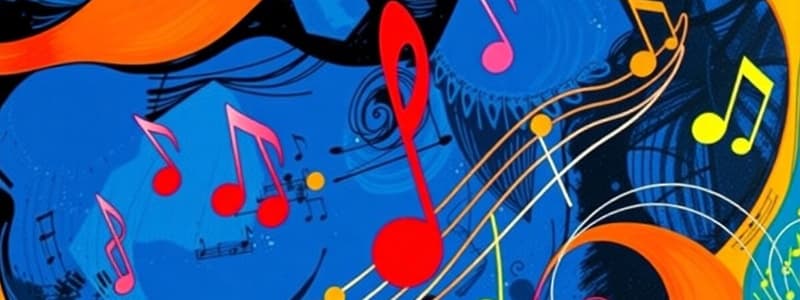Podcast
Questions and Answers
Which statement best describes the nature of music as a sensory experience?
Which statement best describes the nature of music as a sensory experience?
- Music is only experienced through physical vibrations.
- Music can evoke images and narratives in a listener's mind. (correct)
- Music has no relationship to silence.
- Music is only understood through academic study.
What role does 'nurture' play in how individuals perceive music?
What role does 'nurture' play in how individuals perceive music?
- It affects how we think music should sound based on our life experiences. (correct)
- It dictates a universal standard for music appreciation.
- It limits the influence of common musical traits found worldwide.
- It ensures that all people respond the same way to dissonant sounds.
How does classical music differ from popular music in terms of listener engagement?
How does classical music differ from popular music in terms of listener engagement?
- Classical music demands deeper awareness and concentration. (correct)
- Classical music is usually accompanied by a strong beat.
- Classical music is more focused on lyrics than beat.
- Classical music requires little awareness from the listener.
Which element is NOT a primary aspect of sound as defined in music?
Which element is NOT a primary aspect of sound as defined in music?
What is the significance of silence in music according to the provided content?
What is the significance of silence in music according to the provided content?
What is an interval in music?
What is an interval in music?
What best describes a homophonic texture in music?
What best describes a homophonic texture in music?
Which term refers to pitches that sound agreeable and stable?
Which term refers to pitches that sound agreeable and stable?
What role do chords play in music?
What role do chords play in music?
What does the term 'octave' signify in music?
What does the term 'octave' signify in music?
What term refers to the first beat in a measure that receives the strongest accent?
What term refers to the first beat in a measure that receives the strongest accent?
Which of the following best describes 'Tempo' in music?
Which of the following best describes 'Tempo' in music?
Which of the following options is a term that indicates a slowing down of the tempo?
Which of the following options is a term that indicates a slowing down of the tempo?
In a duple meter, how are the beats typically organized?
In a duple meter, how are the beats typically organized?
What does 'Rubato' in music allow for?
What does 'Rubato' in music allow for?
What does pitch refer to in music?
What does pitch refer to in music?
Which term represents very soft dynamics in music?
Which term represents very soft dynamics in music?
What does the term 'crescendo' mean?
What does the term 'crescendo' mean?
Which of the following best describes tone color (timbre)?
Which of the following best describes tone color (timbre)?
How can dynamics in music be altered?
How can dynamics in music be altered?
Which example corresponds to a musical term that signifies moderately loud?
Which example corresponds to a musical term that signifies moderately loud?
What is meant by 'indefinite pitch'?
What is meant by 'indefinite pitch'?
In choosing instruments for a piece, what is a primary consideration?
In choosing instruments for a piece, what is a primary consideration?
What is an essential characteristic of monophonic texture?
What is an essential characteristic of monophonic texture?
Which musical form consists of repeated sections known as strophes?
Which musical form consists of repeated sections known as strophes?
In musical form, what does the process of contrast provide?
In musical form, what does the process of contrast provide?
Which is a common pattern used in Rondo Form?
Which is a common pattern used in Rondo Form?
What distinguishes Ternary Form from other musical forms?
What distinguishes Ternary Form from other musical forms?
How does variation contribute to a musical piece?
How does variation contribute to a musical piece?
Which of the following musical style periods came first?
Which of the following musical style periods came first?
What best defines homophonic texture in music?
What best defines homophonic texture in music?
Which element of music is NOT considered when discussing musical form?
Which element of music is NOT considered when discussing musical form?
What is the primary purpose of using repetition in music?
What is the primary purpose of using repetition in music?
Flashcards are hidden until you start studying
Study Notes
What is Music?
- Music consists of vibrations in the air, interpreted as sounds.
- Evokes spiritual experiences and images or narratives.
- Physically felt, often influencing emotions.
- Includes silence as a fundamental aspect.
- Represented through musical notation for study and discussion.
- Requires delivery as sound, typically through performance.
- Functions as imitation, language, and communication.
Everyday Music Exposure
- Individuals encounter vast amounts of music daily.
- Personal preferences shaped by musical expectations influenced by nature and nurture.
Music Appreciation
- Involves active listening, exploration, and engagement with music.
- Popular Music: Easily accessible, focuses on strong beats and lyrical messages.
- Classical Music: Known as "art music," requires deeper awareness and has a subdued beat.
Elements in Music
Sound: Pitch, Dynamics, Tone Color
- Sound is the vibration transmitted through air, processed by the brain.
- Pitch: Highness or lowness of sound; can set the mood.
- Dynamics: Degree of loudness and softness, with specific terms for various volumes.
- pp: very soft; ff: very loud; cresc.: gradually louder; decresc.: gradually softer.
- Tone Color (Timbre): Quality that defines musical sounds; varies by instrument (e.g., trumpet vs. flute).
Beat, Meter, Tempo
- Beat: Divides musical time; can elicit physical reactions.
- Meter: Organization of beats into measures; includes downbeats (strongest) and upbeats.
- Tempo: Speed of beats, indicated by specific terms (e.g., Allegro: fast, Lento: very slow).
- Tempo changes: Accelerando (speeding up), Ritardando (slowing down), rubato (flexible tempo).
Rhythm
- Organization of time into patterns of long and short sounds.
- Essential for flow in music, as demonstrated in works like Ravel's "Bolero."
Melody
- Series of single tones forming a recognizable musical line.
- Identified by pitch names (A-G) and characterized by direction, shape, and intervals.
Harmony
- Adds depth and richness to melody through supporting pitches.
- Involves chords and chord progressions to enhance emotional depth.
- Consonance: Pitches sounding stable; Dissonance: Pitches sounding unstable or tense.
Musical Texture
- Refers to the density and arrangement of musical elements.
- Three main types:
- Monophonic: Single melodic line without harmony.
- Homophonic: Main melody with accompaniment.
- Polyphonic: Multiple independent melodies occurring simultaneously.
Musical Form
- Organization of musical elements over time.
- Composers use processes like statement, repetition, contrast, and variation.
- Types of musical forms include:
- Strophic: Repeated verses with a refrain.
- Binary: Two contrasting sections (A-B).
- Ternary: Three sections (ABA); includes contrasting style.
- Rondo: Alternating refrain with contrasting sections.
Musical Style
- Common attributes across similar musical works, including rhythm, melody, harmony, texture, and form.
- Eight historical style periods recognized:
- Middle Ages (476-1450)
- Renaissance (1450-1600)
- Baroque Era (1600-1750)
- Classical Era (1750-1820)
- Romantic Era (1820-1900)
- Impressionist Era (1880-1920)
- Modern Era (1900-1985)
- Postmodern Era (1945-present).
Listening to Music
- Encourages deep engagement and critical analysis to enhance understanding and appreciation of musical works.
Studying That Suits You
Use AI to generate personalized quizzes and flashcards to suit your learning preferences.



